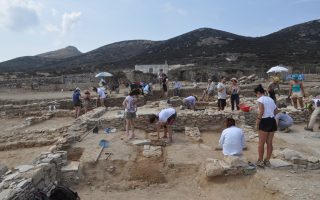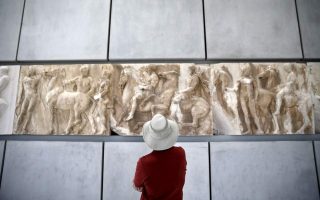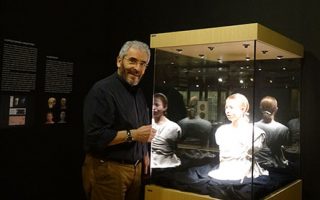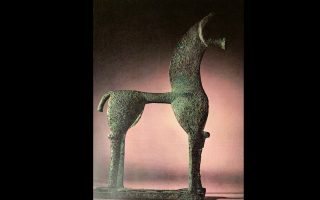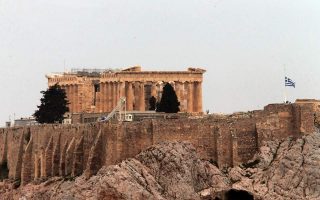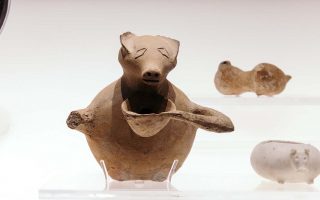Cycladic Ephorate seeks to map archaeological site of Rineia
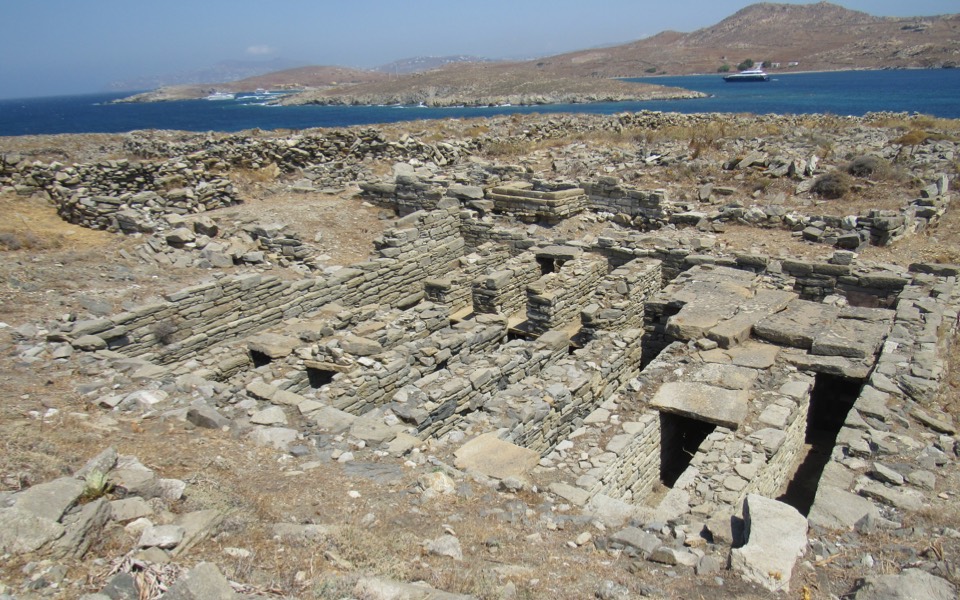
Overshadowed by its better-known yet smaller neighbor Delos, the enchanting and mysterious Cycladic island of Rineia, which is closed to the general public, has a peculiar history that few are familiar with. Nevertheless, it is important because it formed a part of the renowned sacred island of Delos in ancient times and is an archaeology buff’s dream just a short boat ride from the popular holiday destination of Mykonos.
Archaeologists Dimitris Athanasoulis and Zozi Papadopoulou from the Ephorate of Cycladic Antiquities talk to Kathimerini about the island’s history and the five-year field research program they are conducting, together with Maria Sigala.
The program, which is being carried out with the support of the Municipality of Mykonos, got off to a dynamic start last year with a team of scientists from the ephorate, the Parco Archeologico di Pompei, the Federico II University of Naples, the French School at Athens and a number of foreign and Greek university students. Due to restrictions resulting from the health crisis, work this year will mainly be limited to mapping and documenting finds and locations.
“We want to broaden and deepen the archaeological research into Rineia that started a century ago, but we also want to document everything on the island so that it can be protected from any unlicensed activities or antiquities theft. The fact is that Rineia was looted in the 18th and 19th centuries, so now we are documenting everything,” says Athanasoulis, adding that the site is also being mapped in detail, with place names and the location of every structure and find that is made, be it ancient, Byzantine, post-Byzantine or modern.
Fragments of massive bird sculptures and steles collected at the site are on display at the Delos Museum. However, experts also found ancient farmsteads, a road they had no previous knowledge of, and traces of a large altar in a spot called Homasovouni, which has also yielded evidence that there may be an impressive building waiting to be uncovered. The archaeologists believe from existing evidence that the building may be a sanctuary dedicated to Artemis that included a temple, an altar, a dining area and houses.
Archaeological research on Rineia began 120 years ago, thanks to the efforts of the country’s first ephors for the Cyclades, Dimitris Stavropoulos and Dimosthenis Pippas. “They did not manage to record all of their finds,” says Papadopoulou, explaining that Stavropoulos began excavating on the island’s southern coast in 1898, after decades of pillaging. Treasures from Rineia can now be found in museums and collections in Venice, Verona, London, Paris, Vienna, Oslo, Odessa, St Petersburg, Copenhagen and elsewhere.
“Stavropoulos excavated graves and revealed a section of this ‘unique city of births and deaths.’ He was guided in his research by the Third Book of Thucydides’ ‘History of the Peloponnesian War,’ in which he described how, in the winter of 426/5 BC, the Athenians completed the ‘purification’ (started by Peisistratus) of Delos,” says Papadopoulou, describing the process of removing all grave contents to Rineia and decreeing births and deaths banned from Delos.
“When you uproot the dead from one place and command that someone is born somewhere else, you deny them the right of belonging. Another interpretation is that this allowed the Sanctuary of Delos to acquire property on the neighboring island. It is a peculiar story. Everyone, be they the Athenians or Polycrates, sought to control the Sanctuary of Apollo, because it meant money, land and offerings,” says Papadopoulou.
Rineia was a developed city, with activities ranging from the trade in porphyra, the cultivation of wheat, barley and grapes, but also quarrying. Quarries discovered on the northern part of the island suggest that gneiss was a major source of wealth. It was also used to build the foundation of Apollo’s Sanctuary.
Rineia gained some notoriety a few years ago for reports in the press concerning illegal construction on the protected island.
“It is entirely state-owned, so property ownership is not allowed. It is sectioned off into parcels of land, which are rented by the Municipality of Mykonos to local sheep and goat farmers for grazing. Each parcel is allowed to have a small hut for the animals and the shepherd. At some point, a few of them added photovoltaic panels for electricity and others built barbecues,” says Athanasoulis. “Rineia is a part of Delos and needs to remain unsullied. The aim is to have it protected from construction forever,” adds Papadopoulou of the island, which is four times the size of its more famous neighbor.
Rineia also has some interesting modern ruins, like the public sanatorium that was used from the mid-19th to the early 20th century to quarantine ships sailing from the Mediterranean to Greek ports during outbreaks of cholera and other diseases.
The Alexandrian poet Constantine Cavafy also spent some time on Rineia during his first trip to Greece in June 1901, an experience he describes in his diary.
Quarantine at that time lasted from two to 40 days, depending on the risk. Cavafy spent two days there, being examined by doctors whom he describes as all being very nice. He also describes Rineia as being a beautiful place but apparently deserted by farmers.
